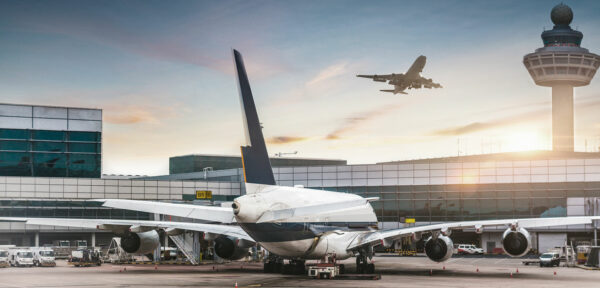As gateways to the world, airports play a crucial role in tourism growth and international trade. Together with airlines and ground handling service providers, airports supported 3.6% of the GDP in 2016. After a decade of sustained development, the industry is now confronted with a new reality. The ongoing Coronavirus has significantly impacted airport traffic with flights grounded worldwide. The Airports Council International reported a decrease in passenger numbers by 58.4% for the first half of 2020 compared to the same period last year. As we learned from the past, the capacity to build airport operational resilience is the key to overcome such declines.
Indeed, this is not the first mass disruption that the sector has faced. Events like the SARS outbreak and the 9/11 terrorist attacks hit air travel in different degrees. Despite the uncertainty, aviation managed to successfully recover by doing what it knows best, adapting. Today, safety measures are being implemented in airport operations to safeguard passengers and employees. However, they bring with them effects like lower capacity utilization and increased processing times which must be considered when planning tasks. COVID-19 is altering airport business operations. Since its end is still unpredictable, managers need to define strategies to respond to health risks, while remaining operative flexible in the long run.
Airport operational resilience: The key to moving forward
1. Evaluate multiple scenarios for optimal resourcing decisions
The current volatility is changing the way airports plan their operations. It is no longer enough to predict what will happen next based only on historical data. Analysts expect that air travel will recover in several steps. Long-haul flights, for instance, may take longer to recover as there is still no coordinated approach to safely re-open borders without quarantine. Decision makers should then evaluate possible scenarios in order to be ready to slow down or ramp up operations when needed. Smart planning is the basis to build airport operational resilience.
The fluctuation in passenger numbers raises questions around how to use resources efficiently. By being agile, managers can plan in variable horizons and react early enough to operational changes. More accuracy in predicting show up profiles and turnaround times will lead to better performance and enhanced cost management. This is possible after translating What-if assessments of the impacts of COVID-19 regulations into resource requirements. For example, if a flight has been booked at almost full capacity, additional staff can be planned to avoid the formation of long queues at gates.
>> Tip: When starting to plan further away from the day of operations, consider buffers in resource allocation to build extra resilience. Later, plans can be adjusted to strike a balance between passenger experience and costs.
2. Prepare to expand capacity utilization
With booking numbers still at low levels, airports may have more capacity available than they actually need. To make their operations more efficient, managers can decide, for instance, whether to limit the number of gates to be used. However, as aviation adapts to the New Normal, it is expected that more travelers will again take to the skies. When traffic volumes start to increase, operators will have to re-adjust their processes. This means sanitary protocols must escalate to mitigate COVID-19 transmission risks. Such changes will directly impact capacity utilization. To meet future requirements optimally, decision makers should now start planning their resources and infrastructure accordingly.
Managing capacity with flexibility is one main ingredient for building airport operational resilience. Determining what staff and equipment are necessary at various traffic levels is important to efficiently use them. From the previous example, airports serving large domestic markets could expect a faster recovery than those serving small ones. Also, from a regional perspective, countries showing stabilized and low virus cases might be able to reactivate air travel faster. In any case, operators should prepare to add some extra capacity to cover the demand. By doing so, unnecessary costs are prevented as airports can better direct their resources to provide services according to current SLAs.

3. Innovation as an enabler to boost passenger confidence
A central element to the process of building airport operational resilience is the passenger experience. The ability to respond to future challenges depends on the operator´s ability to understand the traveler´s psychology and address his concerns. He must perceive that air travel is safe. Subsequently, he will be willing to accept new onboard procedures, security controls and other protocols that are part of the new air travel era.
To smooth the passenger journey, airports can rely on technological innovation. Seeking to minimize human contact, touchless solutions will accelerate in the near future. This includes the use of biometrics to verify traveler identity and the implementation of self-service kiosks to reduce queues at desks. Technologies that were originally conceived to speed up processes, today can make the difference when it comes to keeping the public safe and reducing expenses in the long-term.
4. Adopt solutions to keep costs under control
Not all airports count on their infrastructure to comply with new regulations. Despite the current cost pressure due to the drop in demand, some expenditure may have to take place to assure staff and travelers. Especially once passenger numbers start to rise, more resources will be needed to extend protective protocols on a larger scale.
By reviewing cost structures, managers can identify which traveler services can be temporally suspended without dramatically affecting the whole journey. The idea is to find the balance between desired travel experience and financial constraints to ensure business viability. Exploring the option of offering online services as an alternative to regular ones can help boost demand while reducing overall expenses.
5. Consider structural changes
From the use of plexiglass shields to changing seating configurations, seeking airport operational resilience requires rethinking terminal spaces. For instance, when assigning zones to conduct temperature screenings, calculations must include the space required for equipment, personnel, and passengers. It will be important to ensure that the minimum 1.5 meters distance is maintained.
In the years to come, we can assume that terminal design will undergo a significant transformation. Larger areas will be required for travelers to move easily and safely. Typical high transit zones like security controls could jeopardize the effectiveness of social distancing rules. A solution might be to split these terminal stations into multiple points spread across the airport. As an additional advantage, this arrangement could reduce processing times.
Airport operational resilience is the key to future viability
Previous disruptions in aviation prove that agile adaptation is fundamental to overcoming challenging times. Airports in close cooperation with other stakeholders and industry entities need strategies to make the New Normal in air travel as smooth as possible. Ensuring the well-being of the public demands aligning with the latest health guidance. Through proper communication channels, passengers will be aware of such efforts and feel comfortable flying again.
By building airport operational resilience, managers need not only to focus on implementing protective measures, but to do so optimally. A robust airport is the one that plans for the future, contemplating multiple recovery hypotheses. Perhaps some of the current processes are cumbersome or unnecessary. Solutions aimed to optimize operations and enhance the utilization of resources are crucial for a sustainable recovery.
With revenues difficult to predict, practices to contain costs will dominate in the elaboration of a go-forward plan. At some point, when a vaccine becomes available and travel restrictions ease, airports will have to be ready to ramp up their operations. A flexible, agile and data-driven mindset is essential to get through volatile load factors and flight schedules. The Coronavirus still has no expiration date. Some effects may be temporary, others might be here to stay. However, this can be a chance to learn, to recognize opportunities to improve, and to reflect on the way how airports have been operating over years.





0 comments on “How to Build Airport Operational Resilience to Overcome COVID-19”